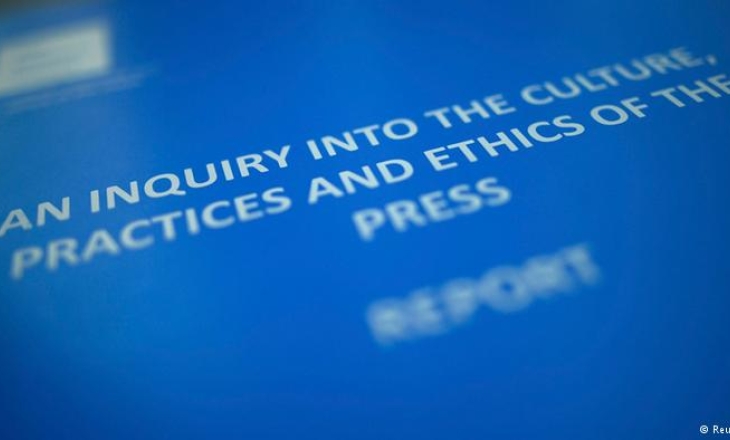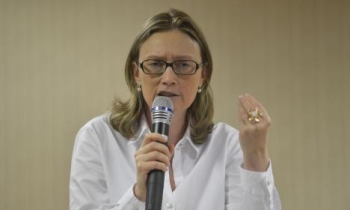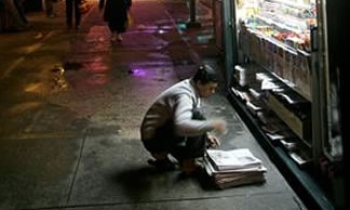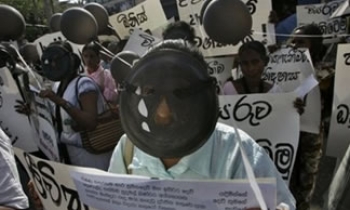Opinionated articles, lack of public opinion, unrepresentative coverage, and failure to back criticism with evidence marked the UK national newspaper coverage of press regulation following the publication of the Leveson Report in November 2012.
The Media Standards Trust, which early September published a comprehensive analysis of newspaper coverage of press regulation following the publication of the Leveson Report in November 2012, found that coverage, including news reports, was highly opinionated – over two-thirds of all articles expressed a view. Opinions expressed were overwhelmingly negative – 60 per cent of articles containing views contained only negative opinions.
The analysis included all 2,047 articles published in print and online by 19 national newspapers about press regulation in the 12-month period from November 29, 2012 (the day of publication of the Leveson Report) to 29 November, 2013 (a month after the sealing of the Royal Charter).
The Leveson Inquiry was a judicial public inquiry into the culture, practices and ethics of the British press following the News International phone hacking scandal, chaired by Lord Justice Leveson, who was appointed in July 2011. A series of public hearings were held throughout 2011 and 2012. The Inquiry published the Leveson Report in November 2012, which reviewed the general culture and ethics of the British media, and made recommendations for a new, independent, body to replace the existing Press Complaints Commission, which would be recognised by the state through new laws.
Highlights of what the 133-page study found:
Press Regulation Coverage: Overall Figures
- Coverage of press regulation in the UK national press was extensive. In the year following the publication of the Leveson Report, 2,047 articles were published across the national daily and Sunday press, an average of 5.6 articles per day as compared to 4.0 per day in the 18 months from July 2011 until publication of the Leveson report in November 2012. There were particularly high levels of coverage in three periods: in the aftermath of the publication of the Leveson Report; around the agreement on the Cross-Party Royal Charter in March 2013; and in October 2013, when the Royal Charter was sealed following the Privy Council’s rejection of the newspaper industry’s own draft Royal Charter.
- The majority of coverage contained some evaluation of Leveson or the Charter. Over two-thirds of articles (1,421 of 2,047, or 69.4 per cent) contained one or more evaluative statements on the Leveson Report and/or the Cross-Party Royal Charter. This was over three times as much as during the 18 months prior to publication of the Leveson Report (436 of 2,016, or 21.6 per cent).
- A majority of the 1,421 articles – news and opinion – which contained an evaluative statement contained only negative viewpoints. 835 articles (58.8 per cent) contained only negative or critical viewpoints. 217 (15.3 per cent) contained only positive or supportive views, and 370 (26.0 per cent) contained both supportive and critical viewpoints.
- Both the Leveson Report and the Cross-Party Royal Charter received a majority of negative coverage. 55.8 per cent of articles containing a view on the Leveson Report were entirely critical (i.e. containing not one single positive reference), outnumbering positive articles by three to one. This rises to 64.5 per cent of articles on the Cross-Party Charter, where the ratio is four to one.
- Leveson and the Cross-Party Charter were widely portrayed as a threat to press freedom. In total, 862 articles contained this assertion by a source or by the journalist – over 40 per cent of all articles on any aspect of press regulation. As a proportion of the 1,421 articles containing a viewpoint on Leveson or the Cross-Party Charter, this figure rises to 60.7 per cent.
How Each Newspaper Covered Press Regulation
- The majority of national newspapers contained a high proportion of negative-only coverage of Leveson and the Cross-Party Charter. Certain newspapers featured a significant majority of negative-only coverage: for every article in the Daily Mail that contained only positive viewpoints, there were more than 33 that contained only critical views. In the Sun, this ratio was 1 : 29. Of 18 newspapers that published articles with viewpoints on Leveson or the Charter, 14 contained more negative-only than positive-only articles; in nine titles the imbalance was by a ratio of over five to one.
- Only a minority of coverage – news and opinion – sought to be balanced. Articles, including news articles, tended to express one single view without reference to opposing views: in 15 of 18 newspapers containing articles where views were expressed, the proportion where both positive and negative viewpoints were included was below 30 per cent; in seven titles it was below 20 per cent.
- Coverage of Leveson and the Cross-Party Charter was mostly negative , as contrasted with coverage of the newspaper industry’s Royal Charter and the newspaper industry plans for a new regulator (IPSO) which was mostly positive. While on average only 15.3 per cent of articles containing a view on Leveson or the Charter were wholly positive, 57.7 per cent of articles with a view on the newspaper Industry’s Charter were positive, as were 65.4 per cent of articles containing a view on IPSO. The results suggest that the majority of newspapers gave strong support to the newspaper industry’s own initiatives, and were highly critical of those initiatives that were not led by the newspaper industry.
- There was a structural difference in how sections of the national press covered Leveson and the Cross-Party Charter. After observing differences in coverage across groups of publishers, a separate analysis of those titles published by News UK, DMG Media, Telegraph Media Group, Trinity Mirror, and Northern & Shell found that those titles contained highly negative coverage (70.5 per cent of articles containing a view were ‘negative-only’), a lower proportion of positive coverage (on average, around one positive article for every eight negative articles published), with the ‘threat to press freedom’ frame appearing in 74.5 per cent of articles containing a view. Significantly, this group accounts for over 90 per cent of weekly national newspaper circulation, and three-quarters of the national newspaper market. In contrast, those titles published by Guardian Media Group, Independent Print Ltd, and Pearson contained half as many negative articles proportionally (34.2 per cent of articles), less than half as many instances of the ‘threat to press freedom’ frame (34.4 per cent of articles), a roughly equal ratio of positive to negative articles (1 : 1.2), and were almost twice as likely to publish articles that contained both supportive and critical viewpoints.
Coverage of Press Regulation in Leader and Opinion Articles
- Leader articles and opinion articles were, by a very large margin, hostile to Leveson and the Cross-Party Charter. Out of 197 leader articles in which a view was expressed on Leveson or the Charter, 156 (79.2 per cent) were negative-only and just 7 (3.6 per cent) were positive-only. In addition, 272 of 369 opinion articles (73.7 per cent) were negative-only, with 55 (14.9 per cent) positive-only.
- Newspapers belonging to News UK, DMG Media, Trinity Mirror, Telegraph Media Group and Northern & Shell were far more likely to be negative than those published elsewhere. The relevant opinion and leader articles published by this group of titles were extremely hostile to Leveson and the Cross-Party Charter:
- 90.8 per cent of all such articles were negative-only (347 of 382);
- For every positive-only opinion or leader article published by these newspapers, more than 30 negative-only articles were published;
- 84.8 per cent of leader or opinion articles by these titles contained the argument that Leveson or the Charter represented a threat to press freedom.
Coverage of Press Regulation in Factual Articles
- A majority of factual news coverage (i.e. news reports and features) contained statements for or against Leveson or the Royal Charter. 806 News articles (66.7 per cent of the total) and 49 Feature articles (43.8 per cent) contained evaluative viewpoints on Leveson or the Charter. For News articles, this was a fourfold increase on the same measure of coverage in the 18 months prior to the Leveson Report (14.7 per cent). Of these 806 News articles, almost half (46.8 per cent) contained negative-only viewpoints.
- As with opinion-based coverage, most of the press focused considerably more on critical views of Leveson and the Charter. Titles published by News UK, DMG Media, Trinity Mirror, Telegraph Media Group and Northern & Shell were again far more likely to publish articles containing views hostile to Leveson than titles published elsewhere:
- 55.7 per cent of all News articles by these five publishers contained only negative viewpoints, compared with 28.2 per cent in titles published by Guardian Media Group, Independent Print Ltd and Pearson;
- There were considerably fewer articles containing only supportive viewpoints (12.9 per cent versus 29.8 per cent)
- The ‘threat to press freedom’ frame was more prevalent in the newspapers of these five publishers, being present in 65.8 per cent of articles in which any viewpoint was expressed. This compared with 38.2 per cent of such articles by other publishers
How the ‘Threat to Press Freedom’ was portrayed
- The argument that Leveson or the Cross-Party Charter posed a threat to press freedom was very frequently referenced in the national press. 862 articles published on the topic contained the argument – 42.1 per cent of all articles mentioning any aspect of press regulation, and 60.7 per cent of those in which a view of Leveson or the Cross-Party Charter was expressed.
- The claim that press freedom was being threatened was often presented with no supporting evidence, no counter-argument, and without a quote by an identified source. Less than 30 per cent of articles in which the ‘Threat’ argument was made included specific evidence to justify the claim. Only 14.8 per cent of these articles included the counter-argument that Leveson or the Charter did not threaten press freedom or political interference, and less than half based the ‘Threat’ claim on a quote from an identified source.
- The language used to describe Leveson and the Cross-Party Charter was emotive, repetitive, and focused on freedom and government interference. There were hundreds of references to ‘press freedom’ in newspaper coverage of press regulation, and to ‘shackles’, ‘muzzles’, and ‘curbs’ on the press. Certain phrases were repeated across news and opinion articles, and several newspapers, indicating a lack of plurality in the presentation of press regulation. Opinion came increasingly to be presented as fact, crossing the divide from ‘leader’ and ‘opinion’ articles, to factual news articles, and there was evidence of arguments being replicated word-for-word across comment pieces.
How Coverage of Press Regulation Failed to Reflect Public Opinion
- Overall public opinion tended to be at odds with the negative line a majority of newspapers took on Leveson and the Cross-Party Charter. The majority of the public, in most polls (even excluding those commissioned by groups supportive of reform of press regulation) tended to be supportive of legal underpinning, supportive of the Leveson recommendations, and supportive of the Cross-Party Charter agreement reached in March, and of its specific provisions. This was in contrast to the strongly negative coverage of each of these issues in the national daily and Sunday press across the whole period of study.
- Individual newspapers did not reflect the viewpoints of their readership on matters of press regulation. Newspaper readerships displayed considerable consistency in terms of their support for the Leveson recommendations and Cross-Party Charter system. While there was some variation between titles (e.g. Sun readers being less supportive than other titles), each set of readers tended to be, by a ratio of at least two-to-one, in favour of their paper joining the Cross-Party Charter system. When surveyed on other aspects of regulatory reform, they supported legal underpinning, supported the Cross-Party Charter over the Industry Charter, and supported the Cross-Party Charter’s system of independent external review of a new regulatory system.










